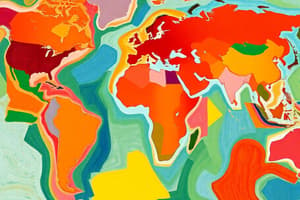Podcast
Questions and Answers
Which of the following is a technique for collecting data about Earth's surface from a distance?
Which of the following is a technique for collecting data about Earth's surface from a distance?
- Geographic Inquiry
- Remote Sensing (correct)
- Fieldwork
- Cartography
What is the main purpose of geographic inquiry?
What is the main purpose of geographic inquiry?
- To predict future weather patterns
- To measure the distance between two points on Earth
- To create detailed maps of the world
- To analyze and interpret spatial phenomena (correct)
Which of the following is NOT an application of geography?
Which of the following is NOT an application of geography?
- Disaster preparedness
- Resource management
- Astrophysics (correct)
- Urban planning
Which of these is a contemporary issue in geography?
Which of these is a contemporary issue in geography?
What does the term 'GIS' stand for?
What does the term 'GIS' stand for?
What is the main focus of physical geography?
What is the main focus of physical geography?
Which of these is NOT a sub-discipline of human geography?
Which of these is NOT a sub-discipline of human geography?
What does the term 'scale' refer to in geography?
What does the term 'scale' refer to in geography?
Which of these is an example of human-environment interaction?
Which of these is an example of human-environment interaction?
What is the primary purpose of Geographic Information Systems (GIS)?
What is the primary purpose of Geographic Information Systems (GIS)?
What is the difference between absolute and relative location?
What is the difference between absolute and relative location?
Which of these BEST describes the concept of a 'region' in geography?
Which of these BEST describes the concept of a 'region' in geography?
What is the main goal of 'sustainability' in geography?
What is the main goal of 'sustainability' in geography?
Flashcards
GIS
GIS
A system for overlaying and comparing different data layers geographically.
Remote Sensing
Remote Sensing
Techniques for collecting data about the Earth's surface from a distance via satellites or aircraft.
Cartography
Cartography
The science and art of mapmaking, including design and interpretation of maps.
Fieldwork
Fieldwork
Signup and view all the flashcards
Geographic Inquiry
Geographic Inquiry
Signup and view all the flashcards
Geography
Geography
Signup and view all the flashcards
Physical Geography
Physical Geography
Signup and view all the flashcards
Human Geography
Human Geography
Signup and view all the flashcards
Region
Region
Signup and view all the flashcards
Interaction
Interaction
Signup and view all the flashcards
Sustainability
Sustainability
Signup and view all the flashcards
Geographic Information Systems (GIS)
Geographic Information Systems (GIS)
Signup and view all the flashcards
Scale
Scale
Signup and view all the flashcards
Study Notes
Introduction to Geography
- Geography studies places and relationships between people and their environments.
- It encompasses physical and human aspects of the world.
- It aims to understand spatial distributions of phenomena and how they are formed and influenced.
Branches of Geography
- Physical Geography: Studies the natural world (landforms, climates, ecosystems, natural resources).
- Sub-disciplines include geomorphology, climatology, hydrology, biogeography, and soil science.
- Human Geography: Explores the human element in geographic space (cultural patterns, economic activities, population distributions, social structures).
- Sub-disciplines include urban geography, population geography, economic geography, and cultural geography.
- Regional Geography: Studies specific regions, focusing on unique characteristics and patterns, integrating human and physical elements.
Key Concepts in Geography
- Place: A specific location with distinct physical and human characteristics.
- Space: Abstract concept of areal extent, location, and distribution.
- Location: A place's position on Earth.
- Absolute location: precise position (latitude, longitude).
- Relative location: position in relation to other places.
- Region: An area with shared characteristics (climate, culture, economic activities).
- Scale: Relationship between map/representation size and real-world area.
- Interaction: Connections between people and places (trade, migration, communication).
- Movement: Flow of people, goods, ideas, and information.
- Human-environment interaction: How people adapt to and modify their environment (conscious and unconscious changes).
- Sustainability: Meeting present needs without compromising future generations' ability to meet their needs.
Geographic Tools and Techniques
- Geographic Information Systems (GIS): Computer systems for storing, analyzing, and displaying geographic data, supporting overlaying and comparisons.
- Remote Sensing: Collecting data about Earth's surface from a distance (satellites, aircraft).
- Cartography: Science of mapmaking (design, data projection, interpretation).
- Fieldwork: Direct observation and data collection in the field, essential for primary data gathering.
Geographic Inquiry
- Analyzing and interpreting spatial phenomena using geographic concepts and tools.
- Investigating "why" questions about geographic patterns and processes.
- Understanding location's influence on human actions and decisions.
- Identifying relationships between physical and human environments.
Applications of Geography
- Urban planning and management
- Environmental conservation and management
- Resource management
- Disaster preparedness and response
- International relations
- Economic development
- Global health and well-being.
Contemporary Issues in Geography
- Climate change impacts
- Population growth and urbanization
- Global inequality and development
- Environmental degradation and resource depletion
- Geopolitical conflicts and territorial disputes.
Studying That Suits You
Use AI to generate personalized quizzes and flashcards to suit your learning preferences.




